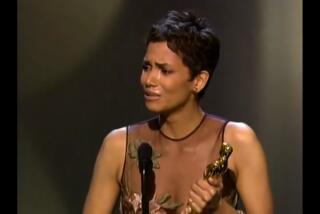7 Oscar-contending directors examine their films’ pivotal scenes
In any given film, there is a scene that brings the whole project together for the director. It can be the climax of a long-running action sequence or it can be the smallest shift in an actor’s face that tells the audience something has changed within the hero. It can be a scene that reveals the world in which the story will take place or a scene that leaves audiences to wonder what becomes of the hero once the film has stopped. The Envelope talked with seven directors with pictures out this year, and each shared a moment that gets to the heart of his film.

Watch a clip from “Love & Mercy.”
Bill Pohlad, “Love and Mercy”
“For me, the pivotal scene is when young Brian, the Paul Dano character, is in the studio. His father has just come in boasting about the new band he’s involved with and he’s getting a lot of pressure from his brothers and band mates about the directions he’s been going in. In disgust he goes back into the studio by himself while the others are still in the control room and he hears a sound in the headphones. It’s kind of a reflection and indication of what is going on in Brian’s life at that time. The sounds that he hears in his head have always been the source of his musical genius and his success, but they come at a price too. So this is a time that he hears them and realizes that it’s a little bit out of his control now and going in a bad direction. These sounds are more frightening and more threatening to him. It’s a very emotional scene when the source of his joy and the beauty he can create is also turning on him in a pretty negative way.”
George Miller, “Mad Max: Fury Road”
“The scene at the very end where the war rig crashes, we had one take. Initially, I thought I wasn’t going to put a stunt driver in the vehicle because there is a lot of energy in that massive vehicle. It’s a tanker and the whole thing flipping, it had to land between two big rocks right in front of a high-speed phantom camera which is running at about 1,000 frames a second and you only got one take. I thought initially we’ll do it CG, but we couldn’t do it in CG because everything else in the movie is real. Then we thought, “Let’s do it with models.” And models sometimes work really well, but mainly at night. Then they made a remote control vehicle and you could drive it with a fair bit of accuracy, but to hit it at exactly the right moment, to flip, land and to come right into that sweet spot, they couldn’t get that degree of accuracy. So we put a lot of effort into making Lee Adamson, the driver, safe and getting it all rehearsed properly. We had to wait for a break for the sunlight and had a very narrow window to shoot it. And I thought, ‘If he doesn’t pull it off and hit that sweet spot, what’s the point of a great stunt and not getting it in your key cameras?’”
John Crowley, “Brooklyn”
“For me I think it’s the scene with the young girl on the deck of the ship as Eilis [Saoirse Ronan] is going back to America. It’s the penultimate scene in the film and it is a key scene for me because it’s a scene you realize just how far Eilis has come. It’s a moment where Eilis is staring back at Ireland and she’s lost in melancholy grief about leaving home again and the fact she may never see her mother again. Here’s this young girl trying to get a conversation going with Eilis. ‘I’m going to Brooklyn. Have you heard of it?’ The gentle irony is floating up and she just doesn’t want to talk to her. And then a moment comes in her face and she just decides to be kind. She turns around and starts giving the girl advice. It suggests something that is very close to the heart of the film. That is: Nobody prepares you for these events in life. You often wind up counting on the kindness of strangers.”
Lenny Abrahamson, “Room”
“I picked a sequence that begins when Ma [Brie Larson] is putting Jack [Jacob Tremblay] to bed for the first time in the wardrobe where he sleeps and she sings for him. He then wakes up a little bit later because he hears the outside door opening and Old Nick [Sean Bridgers] arrives. We see the scene unfold between Old Nick and Ma from inside the wardrobe. It’s the point of the film where we get our first sort of complete sense of how this world works. Who they are, why they are there and the particular challenges for Ma in keeping Jack safe. Because one of the big challenges in making the film is how do you deal with Jack’s point of view? How do you give the naiveté of the kid and the real darkness and challenges of the place where he’s growing up? This is a point where that challenge is really posed, and if I couldn’t get that right I don’t think we would have had a film.”
James Vanderbilt, “Truth”
“There is a scene in the bar, early on, after they have run the Abu Ghraib report where Mary [Cate Blanchett] and Dan [Robert Redford] are having a drink. They share this sort of moment, they share this sort of look and what that establishes is their relationship. That’s the thing that is at stake throughout the entire movie.”
Paolo Sorrentino, “Youth”
“If I had to find a most important scene it would probably be the final scene, the concert where the ‘Simple Song’ is finally being performed. I think that scene is the most important because it’s the scene where the hero [Fred Ballinger, played by Michael Caine] decides to give for the last time that emotion that he thought he would not experience anymore. That song that has been the melody throughout the movie is finally being performed.”
Denis Villeneuve, “Sicario”
“It’s the final scene with Benicio Del Toro and Emily Blunt at the end of the movie where they are both meeting for the last time [in her character’s apartment]. It was designed on the day. [It was just myself and the actors] and I asked the crew to step out for a few hours and we agreed on the scene together with Benicio and Emily and then [cinematographer] Roger Deakins came in and we figured out how to shoot it. For me, it was a very beautiful act of cinema where several artists are working together aiming for the same kind of emotion and ideas and at a very specific moment. What Roger Deakins achieved in how he shot the faces — just the work of light on both actors’ faces — is pure poetry. The way Benicio’s eyes are becoming the eyes of a wolf just with pure light. The ideas of the film are nailed in a single moment with two actors facing one another. That’s my favorite scene in the film.”
More to Read
The biggest entertainment stories
Get our big stories about Hollywood, film, television, music, arts, culture and more right in your inbox as soon as they publish.
You may occasionally receive promotional content from the Los Angeles Times.










